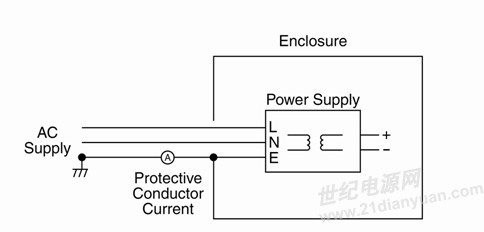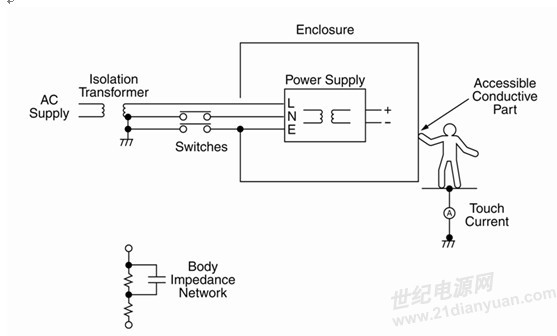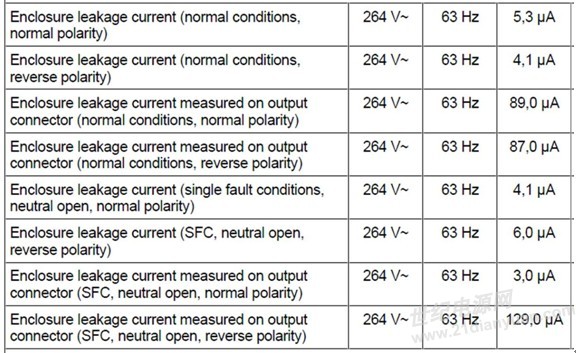Power Supply Leakage Current Testing to IEC60990 基于 IEC60990 - 电源的漏电流测试
A customer recently
asked me why we specify leakage current on a Class II power supply, when a
Class II power supply has no ground terminal.
A good question, but first some background.
一位客户最近询问,为什么II类电源并没有接地端子,却要指定II类电源的漏电流。
As part of the
testing for IEC60950, power supply manufacturers measure leakage current
to the IEC60990 standard.
作为 IEC60950 测试的一部分,电源的制造商要根据 IEC60990 标准来测试漏电流。
To be more accurate,
the terms “Touch Current” and “Protective Conductor Current” replace the term
“Leakage Current”.
更加准确的说,“接触电流”和“保护导体电流”这两个术语将取代“漏电流”这一术语。
Protective
Conductor Current (PCC)
保护导体电流 (PCC)
Is the current that
flows through the protective conductor; commonly referred to as the ground
connection.
流过一般称为接地连接的保护导体的电流。

AC Supply 交流电
Protective Conductor Current 保护导体电流
Power Supply 电源
Enclosure 外壳
As a note, the
withstand voltage and insulation resistance tests measure the current flowing
through the insulation of the unit under test.
注意,耐受电压和绝缘电阻测试时会测量流经被测电源绝缘部分的电流。
Touch Current (TC)
接触电流 (TC)
Is the current that
flows when a human body touches the equipment, simulated by a body impedance
network.
人体接触设备时流过的电流,如下示意是由人体阻抗网络进行模拟。

AC Supply 交流电
Isolation Transformer 绝缘变压器
Switches 开关
Power Supply 电源
Enclosure 外壳
Accessible Conductive Part 可触及导电部分
Touch Current 接触电流
Body Impedance Network 人体阻抗网络
The switches are used
to simulate a line, neutral or ground fault, referred to as a single fault
condition (S.F.C.). Usually there is a
polarity reversal switch to reverse the line and neutral connections to the
power supply.
开关用于模拟火线,零线或接地线故障,称为单一故障条件 (S.F.C.)。通常,使用极性反转开关来改变电源上的火线和零线连接。
So back to theoriginal customer question, if a Class II power supply is used, there will be
current that flows through a human body upon touching conductive parts in a
system (like a USB port or a conductive product case). That measured current is usually listed on
the power supply datasheet.
回到客户的问题,如果使用II类电源,在接触系统的导电部分时(例如 USB 端口或产品的导电外壳),电流将流过人体。所测得的电流一般列在电源数据表中。
Here is an excerpt
from a CB report showing the test, input voltage, frequency and the measured
touch current. Note half the tests
conducted were with the simulated human body touching the “output connector” or
pins of the power supply.
这是从CB 测试报告里摘录,输入电压、频率,以及测得的接触电流。请注意,所执行的一半测试使用了模拟的人体来接触“输出连接器”或电源的引脚。

Enclosure leakage current (normal conditions,
normal polarity)
机壳漏电流(正常状态,正常极性)
Enclosure leakage current (normal conditions,
reverse polarity)
机壳漏电流(正常状态,反向极性)
Enclosure leakage current measured on output
connector (normal conditions, normal polarity)
输出连接器上测得的机壳漏电流(正常状态,正常极性)
Enclosure leakage current measured on
output connector (normal conditions, reverse polarity)
输出连接器上测得的机壳漏电流(正常状态,反向极性)
Enclosure leakage current (single fault
conditions, neutral open, normal polarity)
机壳漏电流(单一故障条件,零线开路,正常极性)
Enclosure leakage current (SFC, neutral
open, reverse polarity)
机壳漏电流(单一故障条件,零线开路,反向极性)
Enclosure leakage current measured on
output connector (SFC, neutral open, normal polarity)
输出连接器上测得的机壳漏电流(单一故障条件,零线开路,正常极性)
Enclosure leakage current measured on
output connector (SFC, neutra
电源漏电流测 相关文章:
- 电源设计小贴士 1:为您的电源选择正确的工作频率(12-25)
- 用于电压或电流调节的新调节器架构(07-19)
- 超低静态电流电源管理IC延长便携应用工作时间(04-14)
- 电源设计小贴士 2:驾驭噪声电源(01-01)
- 负载点降压稳压器及其稳定性检查方法(07-19)
- 电源设计小贴士 3:阻尼输入滤波器(第一部分)(01-16)
